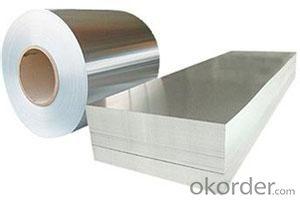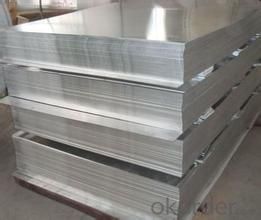Large Anodized Mill Finish Aluminum Sheet, Strip, Plate Hot Wholesale in China
- Loading Port:
- China main port
- Payment Terms:
- TT or LC
- Min Order Qty:
- 1000 m.t.
- Supply Capability:
- 1000 m.t./month
OKorder Service Pledge
OKorder Financial Service
You Might Also Like
Aluminium is a relatively soft,durable, lightweight, ductile and malleablemetal with appearance ranging from silvery to dull gray,depending on the surface roughness. It is nonmagnetic and does not easilyignite. A fresh film of aluminium serves as a good reflector (approximately92%) of visible light and an excellent reflector (as much as98%) of medium and far infrared radiation. The yield strength of pure aluminium is 7–11 MPa,while aluminium alloys have yield strengths ranging from200 MPa to 600 MPa. Aluminium has about one-third the density and stiffnessof steel. It iseasily machined,cast, drawn and extruded.
Alu Plate
Alloy: AA1050, 1060, 1100, AA3003, 3005, 3015, 5052, 5754, 5083,8011,etc
Temper:H14/16/18/22/24/32,HO etc.
Thickness:0.2mm—100mm
Width:100mm—2300mm (Can be slitted)
Application: Foil stock, Circles, Roofing, Canstock, Marine plate,Anti-sliperypurpose in vehicles, packing and appliance.
Features:
1. Excellent quality of products
2. Quick delivery
3. Best service to clients
4. BV,SGS avalible
5. No buckle o waveness
6. Tension leveling
7. Certificate of Origin
8. Form A,E
Packaging Detail: Carton ,Wooden pallet with plastic protection packing,standard seaworthy packing or as your request.
ProductionCapacity:
AnnualProduction capacity of 600,000 tons.
Products areexported to United States, Canada, U.A.E, Brazil, Mexico,Thailand, Vietnam,Nigeria etc, over 100 countries andregions all over the world.
Coveredfactories with full production line
CNBM aluminumproduction base is comprised of 18 aluminumannealers, 10 coil and foilmills, 4 continuous production lines, 2hot rolling production line and 3prepainted lines.
FAQ:
1. What is the form of payment?
Normally 30% TT, L/C
2. Type of quotation?
FOB, CFR, CIF
3. Port of loading?
Shanghai port
4. Delivery time?
30 day after client’s deposit
Automotive aluminum production core technology is in a continuous annealing heat treatment and surface treatment, furnace, hot rolling mill, coiling machine, cold rolling mill and continuous heat treatment furnace air cushion. Modern production line of a hot rolling mill generally comprises a reversible breakdown mill and a finishing mill followed by high-speed, single-stand cold rolling mill is usually reversible. Melting, hot rolling and cold rolling process no significant difference with conventional aluminum production process, so the appropriate equipment without special requirements.
Continuous annealing process selected air furnace equipment including decoiler, degreasing tank, oven, district heating, district cooling, coiling machines, static and dynamic airflow furnace like matted strip propped up the board, while achieving heating or cooling. Aluminum plate floating in the furnace stable at a certain height uses the speed of the airflow to ensure high-speed aluminum plate heat exchanger. By controlling the speed of the aluminum plate in the furnace, the furnace temperature furnace suffered tension and pressure to achieve the solution treatment of the aluminum plate.
Air furnace hot zone furnace temperature accuracy of overseas high-level solution treatment can be controlled to ± 1.5 ℃, the corresponding sheet temperature at ± 2 ℃, while domestic air furnace temperature control accuracy of ± 3 ℃. Currently Chinese manufacturers of equipment can not meet the production of automotive sheet required precision, the entire automotive sheet production line equipment to be imported.
Most of the domestic automobile industry, aluminum plate production companies do not have the background and related technology base, still in imitation stage abroad, the theoretical mechanism and technically at a disadvantage. But most of the domestic aluminum manufacturers and domestic brands of car manufacturers have a good basis for cooperation, the price also has certain advantages, but workable, it can be tailored according to the actual needs of automobile manufacturers.
Whether from the demand of the national strategic level, or the strength of domestic manufacturers of technology, the automotive the aluminum plate volume applications are no doubt. Domestic market demand is amazing, which is the foreign-related enterprises entered reason. In order to meet the needs of automotive lightweight, it will evolve many alternative materials, including aluminum long-term challenge is a strong opponent of steel. Aluminum large number of applications is limited by raw materials and manufacturing costs are high, the industrial structure, recovery and management factors, along with the development of technologies that will limit the breakthrough.
- Q: I'm 17 and it has been very hard finding a deodorant that makes me stop sweating. I told my dad I wanted to get Ban or Mitchum cause the percentage of Aluminum is very high. He said the Aluminum in deodorant has links to alzheimers, is that true? Also my sister said I could just scrub with soap morning and night, use regular deodorant without antipersperant and that would make me stop sweating too. But since i'm a teenager and my hormones are still weird would that be strong enough to stop sweat?
- aluminum oxide in antipersperant does lead to alzheimer's, yes. but antiperspirant is not deodorant, and deodorant does not contain aluminum. sweating is a natural bodily function. if you need to sweat, sweat. it's odor that should bother people.
- Q: How does the thickness of aluminum sheet affect its formability?
- The thickness of an aluminum sheet directly affects its formability. Thinner sheets are generally more flexible and easier to bend or shape, making them more formable. On the other hand, thicker sheets are less malleable and require more force to bend or form, resulting in reduced formability.
- Q: Can the aluminum sheets be used for manufacturing food packaging?
- Yes, aluminum sheets can be used for manufacturing food packaging. Aluminum is a popular choice for food packaging due to its non-reactive nature, resistance to corrosion, and ability to maintain the freshness and quality of food products.
- Q: Can aluminum sheets be formed into seamless tubes or pipes?
- Yes, aluminum sheets can be formed into seamless tubes or pipes through a process called extrusion.
- Q: This question asks for guidance on selecting aluminum sheets based on their intended use, implying a need for criteria or factors to consider when making such a choice.
- <p>When choosing aluminum sheets for different purposes, consider the following factors: 1) Thickness: Depending on the strength and durability required, select the appropriate thickness. 2) Alloy Type: Different alloys have varying properties; for instance, 1100 series is purest and softest, while 6000 series offers high strength. 3) Surface Finish: Choose between mill finish, anodized, or coated finishes based on aesthetic and functional needs. 4) Temper: This refers to the hardness and strength, with options like O (annealed), H14 (strain hardened), and T6 (solution heat treated). 5) Application: Consider the specific use, such as construction, automotive, or aerospace, as each may require specific properties. Always consult with a supplier or engineer for advice tailored to your project's needs.</p>
- Q: Can 101 aluminum sheets be perforated?
- Yes, 101 aluminum sheets can be perforated. Perforation is the process of creating a pattern of holes in a material, and aluminum is a commonly perforated material due to its versatility and durability. The number "101" in this context likely refers to the alloy type or specific grade of aluminum, which does not affect its ability to be perforated. Therefore, 101 aluminum sheets can be easily perforated using various methods such as punching, laser cutting, or drilling, depending on the desired hole pattern and size.
- Q: Can aluminum sheets be used together with other materials, specifically insulation materials?
- <p>Yes, aluminum sheets can be used in combination with other materials, including insulation materials. Aluminum is often used as a cladding material due to its durability and resistance to corrosion. When combined with insulation materials, it can enhance the thermal performance of a structure by reducing heat transfer. This combination is common in construction and roofing applications, where aluminum sheets can provide a protective outer layer while the insulation material manages thermal control. The use of aluminum with insulation materials can lead to energy-efficient buildings and improved indoor comfort.</p>
- Q: How do you protect aluminum sheets from scratches?
- To protect aluminum sheets from scratches, there are a few steps you can take: 1. Handle with care: When handling aluminum sheets, always be mindful of their vulnerability to scratches. Avoid dragging or sliding them across rough surfaces, as this can cause scratches. Instead, lift and place them gently, ensuring you have a clean, smooth surface to work on. 2. Use protective covering: Before storing or transporting aluminum sheets, consider using a protective covering such as a plastic film or paper. This will provide a barrier and prevent direct contact with other surfaces, reducing the risk of scratches. Ensure that the covering is clean and free from any dirt or debris. 3. Store in a safe environment: When not in use, store aluminum sheets in a clean and dry environment. Avoid storing them alongside abrasive materials or objects that could potentially scratch them. Additionally, consider using dividers or separators to create individual compartments for each sheet, preventing them from rubbing against each other. 4. Clean with caution: When cleaning aluminum sheets, use a soft, non-abrasive cloth or sponge. Avoid using wire brushes or rough materials that can cause scratches. Additionally, use a mild detergent or aluminum cleaner specifically designed for this purpose. Rinse thoroughly and dry the sheets completely to prevent any moisture from causing damage. 5. Apply a protective coating: Another option to protect aluminum sheets from scratches is to apply a protective coating. There are various types of coatings available, such as clear lacquers or specialized aluminum protectants. These coatings create a thin barrier on the surface of the aluminum, adding an extra layer of protection against scratches. By following these steps, you can significantly reduce the risk of scratches on your aluminum sheets and help maintain their appearance and integrity over time.
- Q: Can aluminum sheet be used for cookware?
- Indeed, cookware can indeed employ aluminum sheets. Aluminum, being renowned for its superb heat conductivity, facilitates even heat dispersion and rapid heating. It possesses the attributes of being lightweight, long-lasting, and impervious to rust and corrosion. Moreover, aluminum cookware is reasonably priced and comparatively effortless to maintain. Nevertheless, pure aluminum proves to be a malleable metal, thus necessitating its amalgamation with other substances such as stainless steel or nonstick coatings to fortify its endurance and nonstick qualities.
- Q: Can aluminum sheets be used for insulation purposes?
- Yes, aluminum sheets can be used for insulation purposes. They have a low thermal conductivity and can effectively reflect heat and cold, making them suitable for insulating applications in various industries such as construction, automotive, and packaging.
Send your message to us
Large Anodized Mill Finish Aluminum Sheet, Strip, Plate Hot Wholesale in China
- Loading Port:
- China main port
- Payment Terms:
- TT or LC
- Min Order Qty:
- 1000 m.t.
- Supply Capability:
- 1000 m.t./month
OKorder Service Pledge
OKorder Financial Service
Similar products
Hot products
Hot Searches
Related keywords

























